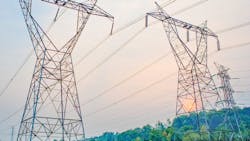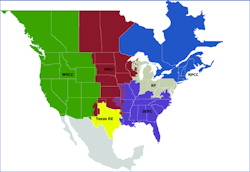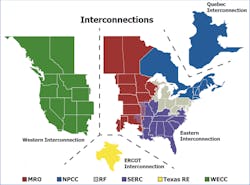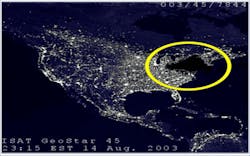Navigating the Complexities Involved with NERC
NERC is an acronym that stands for the North American Electric Reliability Corporation, and if you work in the electric utility industry in the contiguous 48 United States, Canada, or the very northern part of Baja, Mexico, then you must deal with learning about and complying with NERC requirements. Alaska and Hawaii are not included, as they are not connected the rest of the North American electric transmission system (aka “the grid”). NERC’s requirements predominantly only apply to utilities supporting the Bulk Electric System (BES).
Determining what equipment is part of the BES is fairly straightforward, though a little convoluted due to the “extras” from the Inclusions and Exclusions. Here is the BES definition from the NERC public website — Bulk Electric System (BES): Unless modified by the lists shown below, all Transmission Elements operated at 100 kV or higher and Real Power and Reactive Power resources connected at 100 kV or higher. This does not include facilities used in the local distribution of electric energy.
Inclusions:
- I1 ‐ Transformers with the primary terminal and at least one secondary terminal operated at 100 kV or higher unless excluded by application of Exclusion E1 or E3.
- I2 – Generating resource(s) including the generator terminals through the high‐side of the step‐up transformer(s) connected at a voltage of 100 kV or above with:
o Gross individual nameplate rating greater than 20 MVA. Or,
o Gross plant/facility aggregate nameplate rating greater than 75 MVA. - I3 ‐ Blackstart Resources identified in the Transmission Operator’s restoration plan.
- I4 ‐ Dispersed power producing resources that aggregate to a total capacity greater than 75 MVA (gross nameplate rating), and that are connected through a system designed primarily for delivering such capacity to a common point of connection at a voltage of 100 kV or above. Thus, the facilities designated as BES are:
o The individual resources, and
o The system designed primarily for delivering capacity from the point where those resources aggregate to greater than 75 MVA to a common point of connection at a voltage of 100 kV or above - I5 –Static or dynamic devices (excluding generators) dedicated to supplying or absorbing Reactive Power that are connected at 100 kV or higher, or through a dedicated transformer with a high‐side voltage of 100 kV or higher, or through a transformer that is designated in Inclusion I1 unless excluded by application of Exclusion E4.
Exclusions:
- E1 ‐ Radial systems: A group of contiguous transmission Elements that emanates from a single point of connection of 100 kV or higher and:
o Only serves Load. Or,
o Only includes generation resources, not identified in Inclusions I2, I3, or I4, with an aggregate capacity less than or equal to 75 MVA (gross nameplate rating). Or,
o Where the radial system serves Load and includes generation resources, not identified in Inclusions I2, I3 or I4, with an aggregate capacity of non‐retail generation less than or equal to 75 MVA (gross nameplate rating).
Note 1 – A normally open switching device between radial systems, as depicted on prints or one‐line diagrams for example, does not affect this exclusion.
Note 2 – The presence of a contiguous loop, operated at a voltage level of 50 kV or less, between configurations being considered as radial systems, does not affect this exclusion. - E2 ‐ A generating unit or multiple generating units on the customer’s side of the retail meter that serve all or part of the retail Load with electric energy if: (i) the net capacity provided to the BES does not exceed 75 MVA, and (ii) standby, back‐up, and maintenance power services are provided to the generating unit or multiple generating units or to the retail Load by a Balancing Authority, or provided pursuant to a binding obligation with a Generator Owner or Generator Operator, or under terms approved by the applicable regulatory authority.
- E3 ‐ Local networks (LN): A group of contiguous transmission Elements operated at less than 300 kV that distribute power to Load rather than transfer bulk power across the interconnected system. LN’s emanate from multiple points of connection at 100 kV or higher to improve the level of service to retail customers and not to accommodate bulk power transfer across the interconnected system. The LN is characterized by all of the following:
o Limits on connected generation: The LN and its underlying Elements do not include generation resources identified in Inclusions I2, I3, or I4 and do not have an aggregate capacity of non‐retail generation greater than 75 MVA (gross nameplate rating);
o Real Power flows only into the LN and the LN does not transfer energy originating outside the LN for delivery through the LN; and
o Not part of a Flowgate or transfer path: The LN does not contain any part of a permanent Flowgate in the Eastern Interconnection, a major transfer path within the Western Interconnection, or a comparable monitored Facility in the ERCOT or Quebec Interconnections, and is not a monitored Facility included in an Interconnection Reliability Operating Limit (IROL). - E4 – Reactive Power devices installed for the sole benefit of a retail customer(s).
Within the BES definition “extras” are the terms interconnected systems along with various Interconnections.
What Do These Mean?
An interconnected system is just equipment that makes up an Interconnect. Interconnections are different parts of the grid that are directly electrically connected together such that operations and events (e.g. electrical faults, large unit trips, large equipment drops, etc.) in one part impact other parts. The Interconnections are connected to those geographically next to them with limited capability, high-voltage direct current (dc) transmission lines. These lines allow some power flow between the Interconnections but not events.
Within Figures 1 and 2 are six colored areas that represent what are generally referred to as Regional Entities. These Regional Entities are responsible for ensuring compliance with the NERC requirements within their geographic regions and are:
- MRO – Midwest Reliability Organization
- NPCC – Northeast Power Coordinating Council
- RF – Reliability First
- SERC – SERC Reliability Corporation
- Texas RE (TRE) – Texas Reliability Entity
- WECC – Western Electric Coordinating Council
Where Did NERC Come From?
Following the Northeast power blackout in 2003, the Energy Policy Act of 2005 was passed into law and directed the Federal Energy Regulatory Commission (FERC) to designate an Electrical Reliability Organization (ERO) and to give the ERO the responsibility to create reliability standards for the electrical system and the authority to enforce them within the United States. NERC submitted an application to be certified by FERC as the ERO and was subsequently selected in 2006. As the Canadian electrical system was tied in with the U.S. system, the different provinces and territories signed Memorandums of Understanding (MOUs) with NERC to follow its requirements.
Prior to selection as the ERO, NERC, along with the Regional Entities, were voluntary industry groups created by the electrical utilities, to create voluntary operating standards to help ensure the integrity and reliability of the grid.After becoming the ERO, many of the original voluntary standards were used as the basis for the original versions of the, now, mandatory standards. These first “mandatory” standards went into effect in 2007.
The NERC requirements are broken up into the following families of standards.
BAL – Resource and Demand Balancing
- CIP – Critical Infrastructure Protection
- COM – Communications
- EOP – Emergency Preparedness and Operations
- FAC – Facilities Design, Connections, and Maintenance
- INT – Interchange Scheduling and Coordination
- IRO – Interconnection Reliability Operations and Coordination
- MOD – Modeling, Data, and Analysis
- NUC – Nuclear Power Plant requirements
- PER – Personnel Performance, Training, and Qualification
- PRC – Protection and Control
- TOP – Transmission Operations
- TPL – Transmission Planning
- VAR – Voltage and Reactive control
These “family” names make up the first part of the standard number along with a three digit, incrementally increasing, number in the middle and the version (revision) number at the end, e.g. PRC-005-6. Version numbers can also consist of decimal numbers, lower-case roman numerals in parentheses, and lower-case letters, e.g. BAL-002-1.1(i)a.
- Errata are shown by using a period followed by a number to the right of the version number
- Changes within a version are shown by using lower-case roman numerals in parentheses
- Interpretations are shown with a lower-case letter to the right of the version number
Some of the Regional Entities also have standards that are applicable only with their areas. These are indicated by the Regional Entity acronym in the standard number, e.g. IRO-006-WECC-1.
Why Do Companies Need to Follow NERC’s Requirements?
If a company has to follow NERC standards, it much register with NERC as one or more of the following functions:
- Reliability Coordinator (RC) – highest level of authority responsible for the reliable operation of the BES
- Transmission Operator (TOP) – responsible for the operation and reliability of its transmission facilities
- Balancing Authority (BA) – responsible for maintaining balance between generation and load
- Planning Authority/Planning Coordinator (PA/PC) – coordinates transmission facilities and service plans, resource plans, and Protection Systems (relaying)
- Transmission Planner (TP) – develops long-term plan for the reliability of the transmission system
- Transmission Service Provider (TSP) – provides transmission service to transmission customers
- Transmission Owner (TO) – owns and maintains transmission facilities
- Resource Planner (RP) – develops long-term plan for resource adequacy
- Distribution Provider (DP) – provides the electrical connection between the grid and the end-use customers
- Generator Owner (GO) – owns and maintains electrical generating facilities
- Generator Operator (GOP) – responsible for the operation and reliability of its electrical generating facilities
- Reserve Sharing Group (RSG) – two more BAs that collectively maintain operating reserves required by its members
- Frequency Response Sharing Group (FRSG) – two more BAs that collectively meet the frequency response responsibilities of its members
- Regulation Reserve Sharing Group – two more BAs that collectively maintain regulating reserves required by each BA
These functions determine which roles the registered companies (also known as Registered Entities) are responsible for. Within NERC Standards are requirements that are applicable to one or more of the functions. As such, each function only has to comply with the requirements that are applicable to it.
If NERC requirements apply to your organization you have to learn the associated acronym alphabet soup, dig in and learn the requirements applicable to your company, comply with those requirements so as to not get fined and/or sanctioned by NERC, and, most importantly, keep the grid safe and reliable.
Tom Carpenter has over 40 years’ experience in the electrical power industry, primarily supporting electrical generation. He is a licensed electrician and licensed professional engineer. He serves as the treasurer of the IEEE PES Energy Storage & Stationary Battery (ESSB) Committee and the Electrical Energy Storage Applications & Technology (EESAT) Conference, is a Technical Committee member of the international battery conference, BattCon, and is a former Principal Member of the NFPA 70E Technical Committee. Carpenter is a certified high and low voltage electrical safety trainer.
About the Author
Tom Carpenter
Tom Carpenter has over 40 years’ experience in the electrical power industry, primarily supporting electrical generation. He is a licensed electrician and licensed professional engineer. He serves as the treasurer of the IEEE PES Energy Storage & Stationary Battery (ESSB) Committee and the Electrical Energy Storage Applications & Technology (EESAT) Conference, is a Technical Committee member of the international battery conference, BattCon, and is a former Principal Member of the NFPA 70E Technical Committee. Carpenter is a certified high and low voltage electrical safety trainer.



